By using CSS Grid Layout, you can create complex and responsive web layouts for all the devices with ease. In this post, I will guide you through the CSS grid layout and its properties.
Let’s get started!
To get the updated version of this CSS grid layout guide, click here!
What is CSS Grid Layout?
CSS Grid is a powerful layout system that allows you to create complex and responsive web layouts with ease. By using the CSS grid, you can place and align elements precisely within a two-dimensional grid structure.
In simple terms, by using CSS Grid layout, you can organize and align web page elements (like text, images, and buttons) in rows and columns, making it easier to create beautiful and responsive web layouts, that look great on all devices (mobile, tablet and desktop).
Some Important CSS Grid Terminologies
Before diving deep into grid layout you should first know about some grid terminologies.
CSS Grid Container
The element which has the display: grid property on it, is called grid container.
CSS Grid Item
The direct child element of a grid container is called the grid item.
For example:
<div class="container">
<div class="item">
<div class="box"></div>
</div>
</div>CSS:
.container {
display: grid;
}Here, the <div> element with the class ‘container’ is a grid container because it has the display: grid; property.
The second <div> element with the class ‘item’ is a grid item because it is the direct child of the grid container.
Now, will the <div> element with the class ‘box’ be considered a grid item or not?
The answer is no. It will not be considered a grid item because it is not a direct child element of the grid container.
For an element to be a grid item it must be the direct child of the grid container.
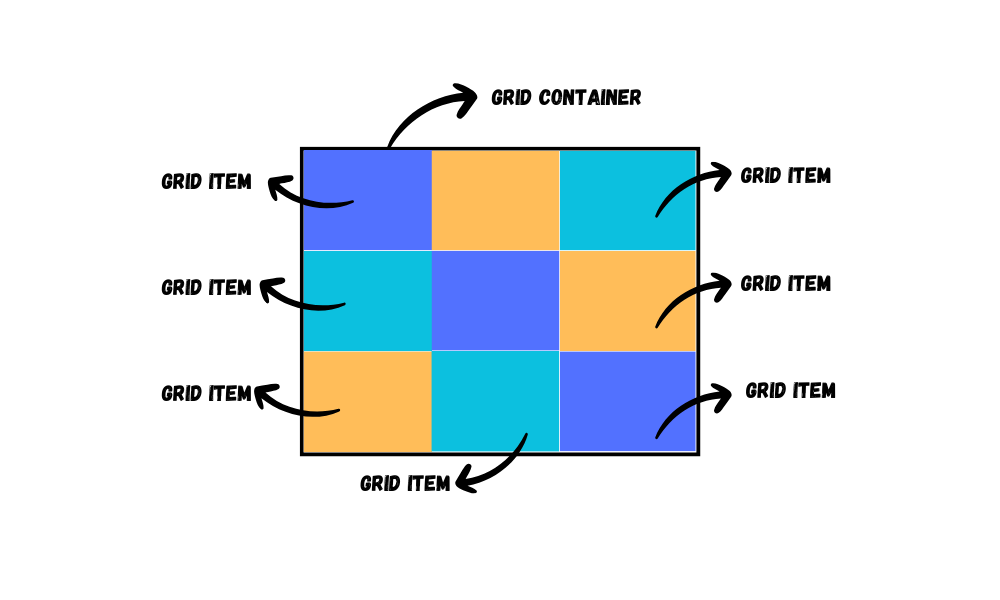
CSS Grid Line
The lines that separate the rows and columns of the grid are grid lines.

CSS Grid Cell
A grid cell is a single unit of the grid, which is created by the intersection of a row and a column.
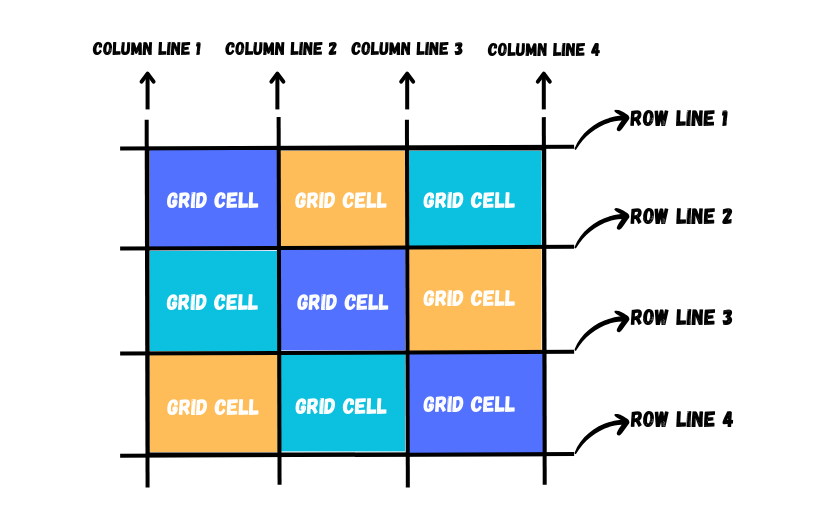
Now you might be thinking, what is the difference between a grid cell and a grid item?
Let me clear this.
A grid cell is a structural component, representing the intersection of rows and columns, while a grid item is a content or element that is positioned within one or more grid cells. Grid cells define the grid’s structure, and grid items are the elements you place within that structure.
CSS Grid Track
The space between two adjacent grid lines is a grid track. It can be horizontal(row) or vertical(column).

CSS Grid Area
A rectangular group of grid cells surrounded by four grid lines is called a grid area. A grid area can contain any number of grid cells.

Gutter
The space between rows and columns in a grid is called gutter.

The fr Unit
Fr is a fractional unit and is used to distribute available space proportionally among grid items. 1fr is for 1 part of the available space.
CSS Grid Properties
We have the following properties for the grid container and grid items.
For all the properties, I will use the following HTML and CSS structure.
HTML:
<div class="container"> <div class="item">Item 1</div> <div class="item">Item 2</div> <div class="item">Item 3</div> <div class="item">Item 4</div> <div class="item">Item 5</div> <div class="item">Item 6</div> <div class="item">Item 7</div> <div class="item">Item 8</div> <div class="item">Item 9</div> </div>
CSS:
.container {
height: 700px;
width: 700px;
background-color: #737373;
}
.item {
background-color: #5ce1e6;
border: 1px solid black;
text-align: center;
}Properties For CSS Grid Container
The following properties are related to the grid container itself which allows you to define the structure and behavior of the grid layout.
display
To create a grid layout, you can apply the display: grid; property to an HTML element. This element becomes the grid container, and its direct children elements are treated as grid items.
.container {
display: grid;
}grid-template-columns
This property is used to define the size and number of grid columns in the grid layout.
Example: 1
.container {
display: grid;
grid-template-columns: 100px 200px;
}This will create two columns one of 100px width and the second of 200px width.

Example: 2
.container {
display: grid;
grid-template-columns: 100px 150px 1fr;
}This will create three columns one of 100px width, the second of 150px width and the third column relative to the fraction of available space in the grid container.

Example: 3
If you want your grid columns to have the same width then you can use the value ‘auto’.
The auto keyword lets the browser determine the size of a track based on its content and available space.
.container {
display: grid;
grid-template-columns: auto auto auto auto;
}This will create four columns of the same width.

Example: 4
.container {
display: grid;
grid-template-columns: 100px 150px auto 60px;
}Output:

grid-template-rows
This property is used to define the size and number of grid rows in the grid layout.
Example: 1
.container {
display: grid;
grid-template-rows: 100px 200px 300px;
}This will create the first row of 100px height, the second row of 200px height and the third row of 300px height.

Example: 2
.container {
display: grid;
grid-template-rows: 100px 1fr 150px;
grid-template-columns: 100px 150px 1fr;
}This will create three rows one of 100px height, the second is relative to the fraction of available space in the grid container and the third is of 150px height.
This will be a grid container of 3 rows and 3 columns.

Example: 3
Let’s create a grid layout of 4 rows and 4 columns.
.container {
display: grid;
grid-template-rows: 100px auto 150px auto;
grid-template-columns: 100px auto 50px auto;
}
grid-template
This property is a shorthand property for defining both the grid-template-rows and grid-template-columns in a single declaration.
Basic syntax:
grid-template: grid-template-rows / grid-template-columns;
For example:
.container {
display: grid;
grid-template: 100px 1fr 2fr / 100px 200px 1fr;
}
grid-auto-columns
This property is used to set a default size for grid columns. grid-template-columns property overrides grid-auto-columns property.
.container {
display: grid;
grid-auto-columns: 100px;
}
grid-auto-rows
This property is used to set a default size for grid rows. grid-template-rows property overrides grid-auto-rows property.
.container {
display: grid;
grid-auto-rows: 70px;
}
column-gap
This property is used to define the gap between the columns of the grid container.
.container {
display: grid;
grid-template-columns: 100px 100px 1fr;
column-gap: 10px;
}
row-gap
This property is used to define the gap between the rows of the grid container.
.container {
display: grid;
grid-template-rows: 100px 100px 1fr;
row-gap: 10px;
}
gap
This property is a shorthand for defining both row-gap and column-gap in a single declaration.
Syntax:
gap: row-gap column-gap;
The values are space-separated.
Example:
.container {
display: grid;
grid-template-rows: 100px 100px 1fr;
grid-template-columns: 100px 100px 1fr;
gap: 10px 20px; /*first value is for row-gap and second value is for column-gap*/
}
justify-items
This property is used to control the horizontal alignment (along the row axis) of grid items.
It has the following values:
- start
- end
- center
- stretch
start
This aligns the items to the start of the grid container.
.container {
display: grid;
grid-template-columns: 1fr 1fr 1fr;
justify-items: start;
}
end
This aligns the items to the end of the grid container.
.container {
display: grid;
grid-template-columns: 1fr 1fr 1fr;
justify-items: end;
}
center
This centers the items horizontally within the grid container.
.container {
display: grid;
grid-template-columns: 1fr 1fr 1fr;
justify-items: center;
}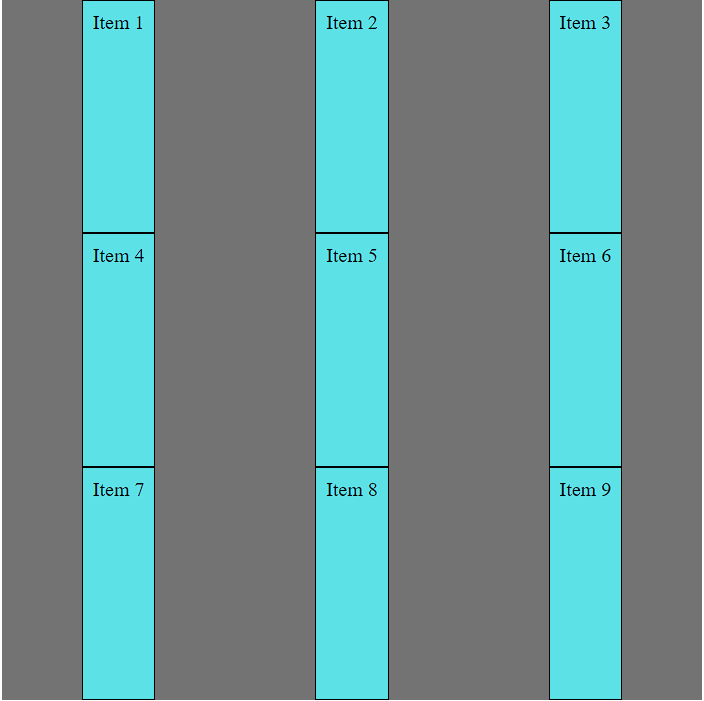
stretch
This stretches the items to fill the entire width of the grid container. This is the default value.
.container {
display: grid;
grid-template-columns: 1fr 1fr 1fr;
justify-items: stretch;
}
align-items
This property is used to control the vertical alignment (along the column axis) of grid items.
It has the following values:
- start
- end
- center
- stretch
start
This aligns the items to the top of the grid container.
.container {
display: grid;
grid-template-columns: 1fr 1fr 1fr;
align-items: start;
}
end
This aligns the items to the bottom of the grid container.
.container {
display: grid;
grid-template-columns: 1fr 1fr 1fr;
align-items: end;
}
center
This centers the items vertically within the grid container.
.container {
display: grid;
grid-template-columns: 1fr 1fr 1fr;
align-items: center;
}
stretch
This stretches the items to fill the entire height of the grid container. This is the default value.
.container {
display: grid;
grid-template-columns: 1fr 1fr 1fr;
align-items: stretch;
}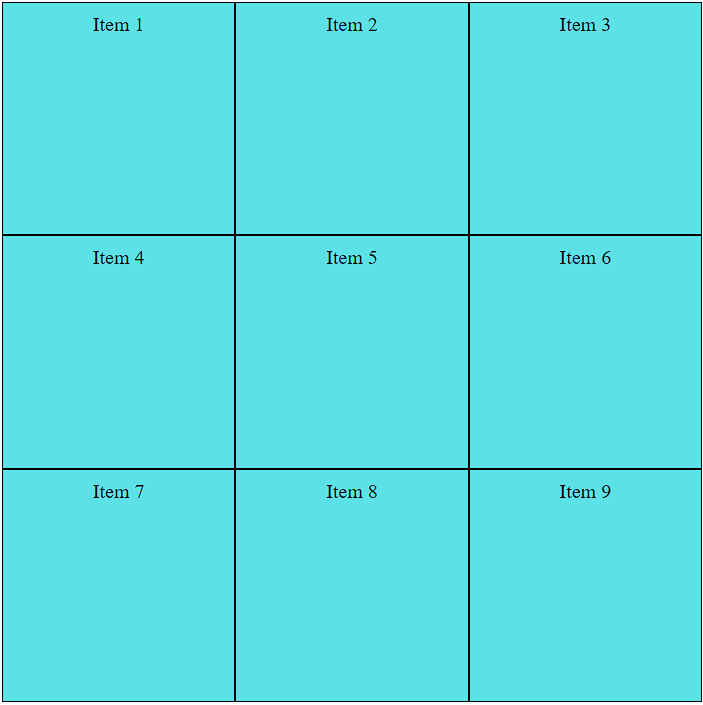
place-items
This property is a shorthand for setting both align-items and justify-items in a single declaration.
Basic syntax:
place-items: align-items justify-items;
The values are space-separated.
Example: 1
.container {
display: grid;
grid-template-columns: 1fr 1fr 1fr;
place-items: start; /*Both values are set to start*/
}
Example: 2
.container {
display: grid;
grid-template-columns: 1fr 1fr 1fr;
place-items: end; /*Both values are set to end*/
}
Example: 3
.container {
display: grid;
grid-template-columns: 1fr 1fr 1fr;
place-items: start stretch; /*first value is for align-items and second is for justify-items*/
}
Example: 4
.container {
display: grid;
grid-template-columns: 1fr 1fr 1fr;
place-items: end start; /*first value is for align-items and second is for justify-items*/
}
You can try different combinations as well with different values of align-items and justify-items.
justify-content
This property is used to control the horizontal alignment (along the row axis) of all the grid content if the total grid size is smaller than the container.
It has the following values:
- start
- end
- center
- space-around
- space-between
- space-evenly
start
Items are aligned to the start of the container.
.container {
display: grid;
grid-template-columns: 50px 60px 50px; /*To make the total size of the grid smaller than the container*/
justify-content: start;
}
end
Items are aligned to the end of the container.
.container {
display: grid;
grid-template-columns: 50px 60px 50px;
justify-content: end;
}
center
Items are aligned to the center of the container.
.container {
display: grid;
grid-template-columns: 50px 60px 50px;
justify-content: center;
}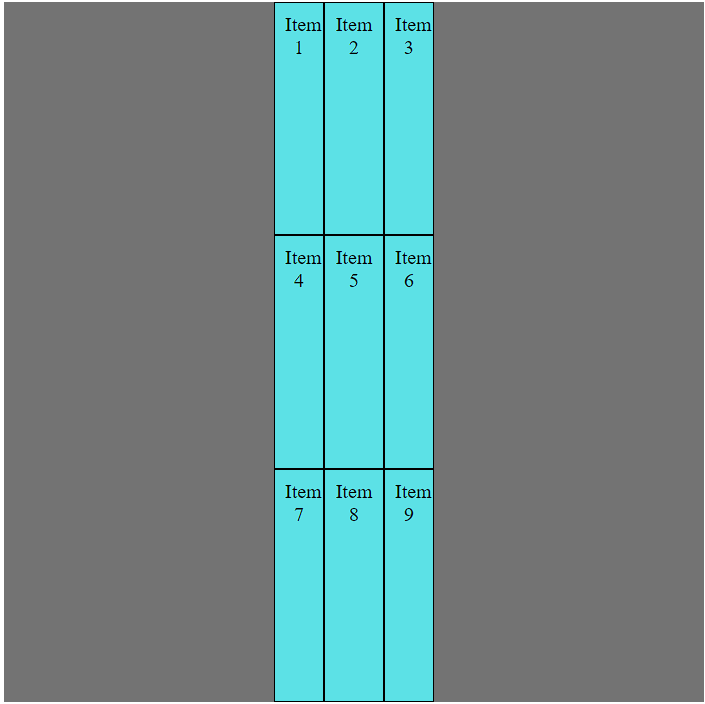
space-between
Items are evenly distributed with equal space between them and the first item at the start and the last item at the end.
.container {
display: grid;
grid-template-columns: 50px 60px 50px;
justify-content: space-between;
}
space-around
Items are evenly distributed with equal space around them.
.container {
display: grid;
grid-template-columns: 50px 60px 50px;
justify-content: space-around;
}
space-evenly
Items are evenly distributed with equal space around and between them.
.container {
display: grid;
grid-template-columns: 50px 60px 50px;
justify-content: space-evenly;
}
align-content
This property is used to control the vertical alignment (along the column axis) of all the grid content if the total grid size is smaller than the container.
It has the following values:
- start
- end
- center
- space-around
- space-between
- space-evenly
start
Rows are aligned to the start of the container.
.container {
display: grid;
grid-template-columns: 50px 60px 50px;
align-content: start;
}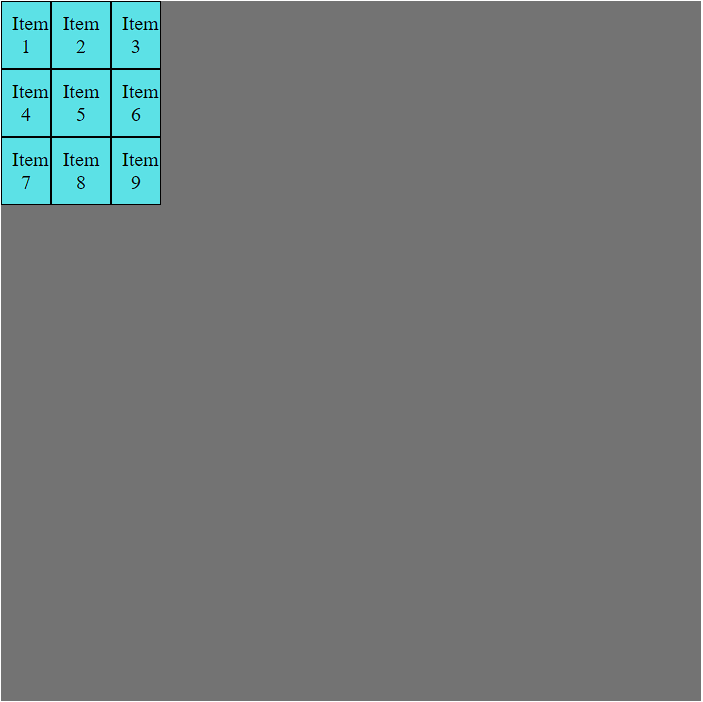
end
Rows are aligned to the end of the container.
.container {
display: grid;
grid-template-columns: 50px 60px 50px;
align-content: end;
}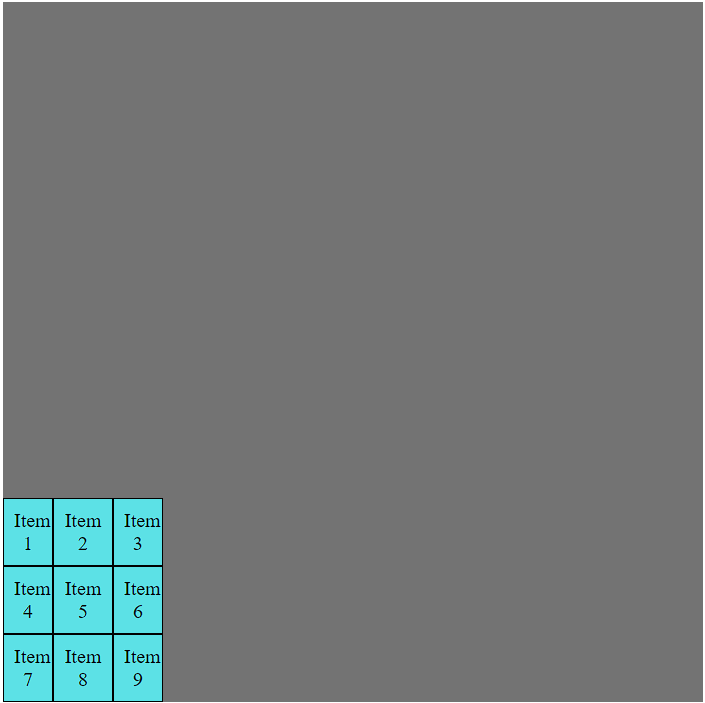
center
Rows are aligned to the center of the container.
.container {
display: grid;
grid-template-columns: 50px 60px 50px;
align-content: center;
}
space-between
Rows are evenly distributed with equal space between them and the first row at the start and the last row at the end.
.container {
display: grid;
grid-template-columns: 50px 60px 50px;
align-content: space-between;
}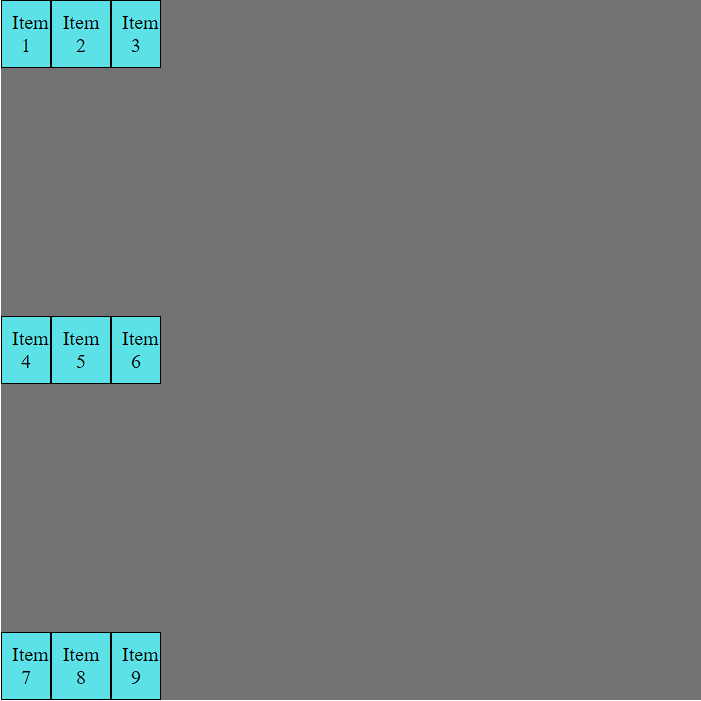
space-around
Rows are evenly distributed with equal space around them.
.container {
display: grid;
grid-template-columns: 50px 60px 50px;
align-content: space-around;
}
space-evenly
Rows are evenly distributed with equal space around and between them.
.container {
display: grid;
grid-template-columns: 50px 60px 50px;
align-content: space-evenly;
}
place-content
This property is a shorthand for setting both align-content and justify-content in a single declaration.
Basic syntax:
place-content: align-content justify-content;
The values are space-separated.
Example: 1
.container {
display: grid;
grid-template-columns: 50px 60px 50px;
place-content: start space-evenly; /*first value is for align-content and second is for justify-content*/
}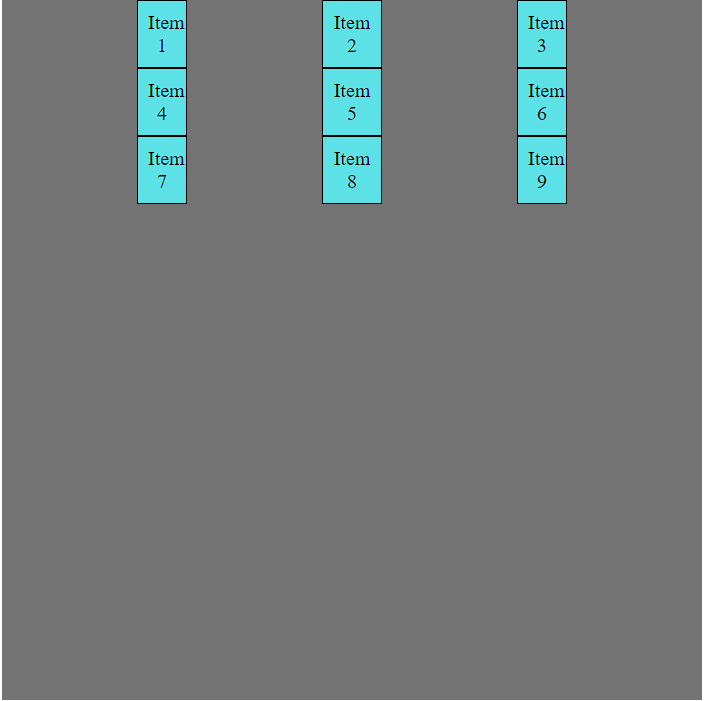
Example: 2
.container {
display: grid;
grid-template-columns: 50px 60px 50px;
place-content: space-between end;
}
You can try different combinations as well with different values of align-content and justify-content.
grid-auto-flow
This property is used to determine how additional grid items will be placed within the grid container when they are not explicitly positioned.
But, what does it mean by explicitly positioned?
Explicitly positioned items are the items that you define using the grid-template-columns or grid-template-rows property.
We have the following values for the grid-auto-flow property:
grid-auto-flow: column;
This value arranges grid items in columns, occupying each column before proceeding to the next one.
.container {
display: grid;
grid-auto-flow: column;
grid-template-rows: 100px 100px;
}You can understand it more clearly by adding and removing the grid-auto-flow property.
grid-auto-flow: row; (default)
This value arranges grid items in rows, occupying each row before proceeding to the next one.
.container {
display: grid;
grid-auto-flow: row;
grid-template-columns: 100px 100px;
}grid-auto-flow: column dense;
This value arranges grid items in columns, but it can leave empty spaces within the grid when smaller items are encountered subsequently.
.container {
display: grid;
grid-auto-flow: column dense;
grid-template-rows: 100px 100px;
}grid-auto-flow: row dense;
This value arranges grid items in rows, but it can leave empty spaces within the grid when smaller items are encountered subsequently.
.container {
display: grid;
grid-auto-flow: row dense;
grid-template-columns: 100px 100px;
}Properties For CSS Grid Items
The following properties are used to control the placement and alignment of individual grid items within a grid container.
justify-self
This property is used to control the horizontal alignment of a specific grid item within its grid cell. It overrides the horizontal alignment set for the entire grid container.
It has the following values:
- start
- end
- center
- stretch
start
This aligns the item to the start of its grid cell.
.container {
display: grid;
grid-template-columns: 1fr 1fr 1fr;
}
.item:nth-child(3) {
justify-self: start;
}
end
This aligns the item to the end of its grid cell.
.container {
display: grid;
grid-template-columns: 1fr 1fr 1fr;
}
.item:nth-child(3) {
justify-self: end;
}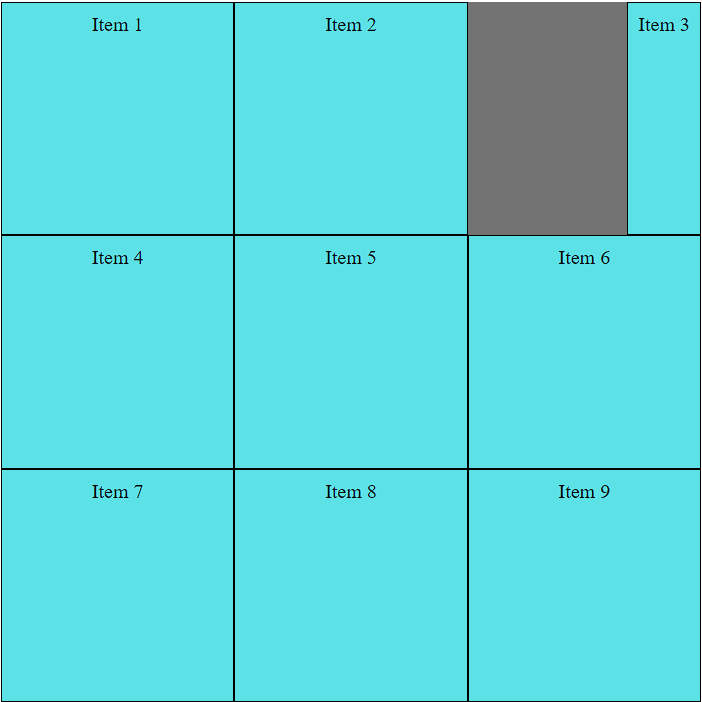
center
This centers the item horizontally within its grid cell.
.container {
display: grid;
grid-template-columns: 1fr 1fr 1fr;
}
.item:nth-child(3) {
justify-self: center;
}
stretch
This stretches the item to fill the entire width of its grid cell.
.container {
display: grid;
grid-template-columns: 1fr 1fr 1fr;
}
.item:nth-child(3) {
justify-self: stretch;
}
align-self
This property is used to control the vertical alignment of a specific grid item within its grid cell. It overrides the vertical alignment set for the entire grid container.
It has the following values:
- start
- end
- center
- stretch
start
This aligns the item to the top of its grid cell.
.container {
display: grid;
grid-template-columns: 1fr 1fr 1fr;
}
.item:nth-child(3) {
align-self: start;
}
end
This aligns the item to the bottom of its grid cell.
.container {
display: grid;
grid-template-columns: 1fr 1fr 1fr;
}
.item:nth-child(3) {
align-self: end;
}
center
This centers the item vertically within its grid cell.
.container {
display: grid;
grid-template-columns: 1fr 1fr 1fr;
}
.item:nth-child(3) {
align-self: center;
}
stretch
This stretches the item to fill the entire height of its grid cell.
.container {
display: grid;
grid-template-columns: 1fr 1fr 1fr;
}
.item:nth-child(3) {
align-self: stretch;
}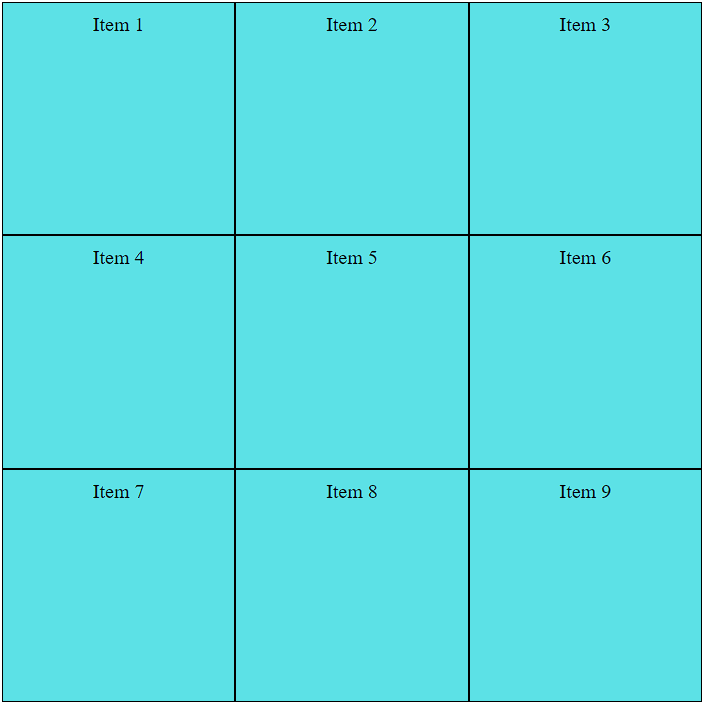
place-self
This property is a shorthand for setting both align-self and justify-self in a single declaration.
Basic syntax:
place-self: align-self justify-self;
The values are space-separated.
Example: 1
.container {
display: grid;
grid-template-columns: 1fr 1fr 1fr;
}
.item:nth-child(3) {
place-self: start end; /*first value is for align-self and second is for justify-self*/
}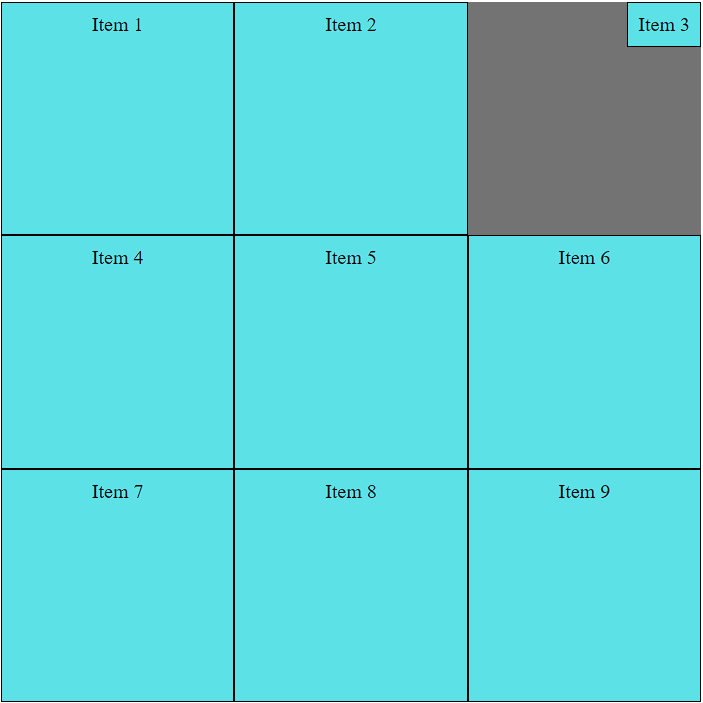
Example: 2
.container {
display: grid;
grid-template-columns: 1fr 1fr 1fr;
}
.item:nth-child(3) {
place-self: stretch start; /*first value is for align-self and second is for justify-self*/
}
You can try different combinations as well with different values of align-self and justify-self.
grid-row-start
This property is used to define where a grid item starts in a row.
.container {
display: grid;
grid-template-columns: 1fr 1fr 1fr;
}
.item:nth-child(3) {
grid-row-start: 3;
background-color: rgb(182, 182, 82);
}Here, the third grid item will start at the row grid line 3.

grid-column-start
This property is used to define where a grid item starts in a column.
.container {
display: grid;
grid-template-columns: 1fr 1fr 1fr;
}
.item:nth-child(3) {
grid-column-start: 2;
background-color: rgb(182, 182, 82);
}Here, the third grid item will start at column grid line 2.

grid-row-end
This property is used to define where a grid item ends in a row.
.container {
display: grid;
grid-template-columns: 1fr 1fr 1fr;
}
.item:nth-child(3) {
grid-row-end: 2;
background-color: rgb(182, 182, 82);
}Here, the third grid item will end at the row grid line 2.
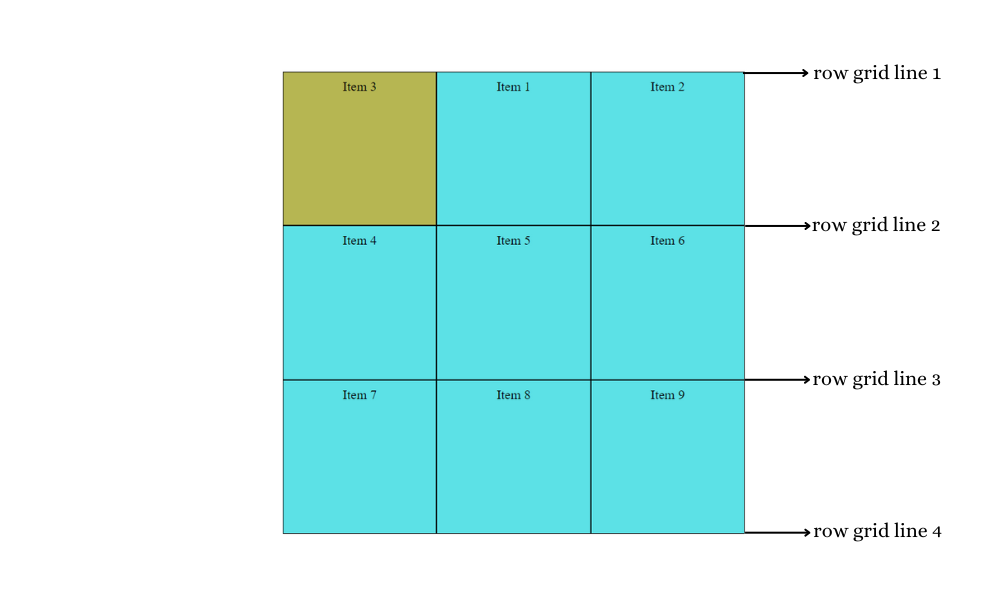
grid-column-end
This property is used to define where a grid item ends in a column.
.container {
display: grid;
grid-template-columns: 1fr 1fr 1fr;
}
.item:nth-child(3) {
grid-column-end: 3;
background-color: rgb(182, 182, 82);
}Here, the third grid item will end at column grid line 3.
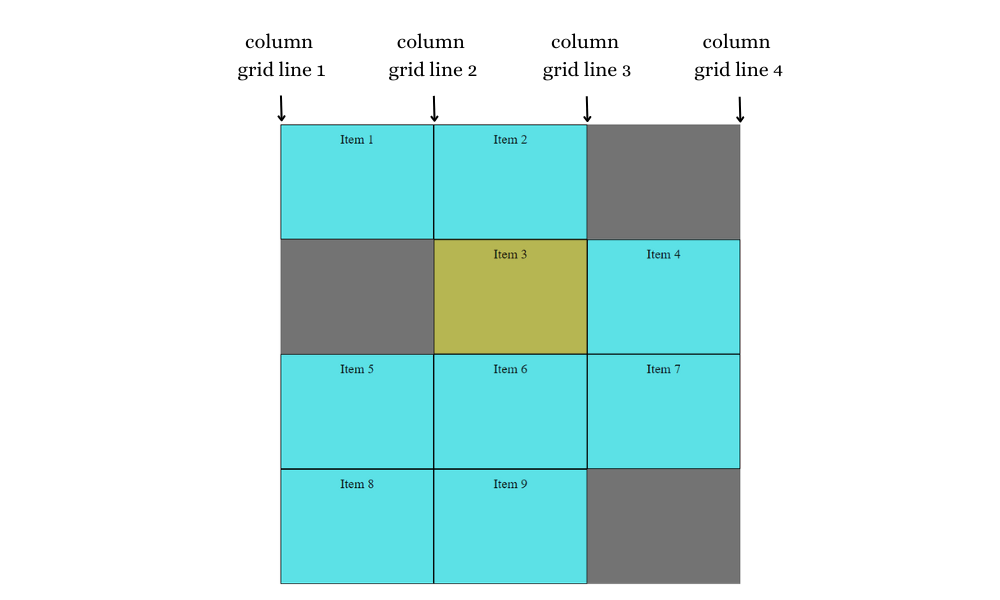
Examples for grid-row-start, grid-column-start, grid-row-end and grid-column-end
Example: 1
.container {
display: grid;
grid-template-columns: 1fr 1fr 1fr;
}
.item:nth-child(3) {
grid-column-end: 3;
grid-column-start: 1;
background-color: rgb(182, 182, 82);
}
Example: 2
.container {
display: grid;
grid-template-columns: 1fr 1fr 1fr;
}
.item:nth-child(3) {
grid-row-start: 2;
grid-row-end: 4;
grid-column-end: 3;
background-color: rgb(182, 182, 82);
}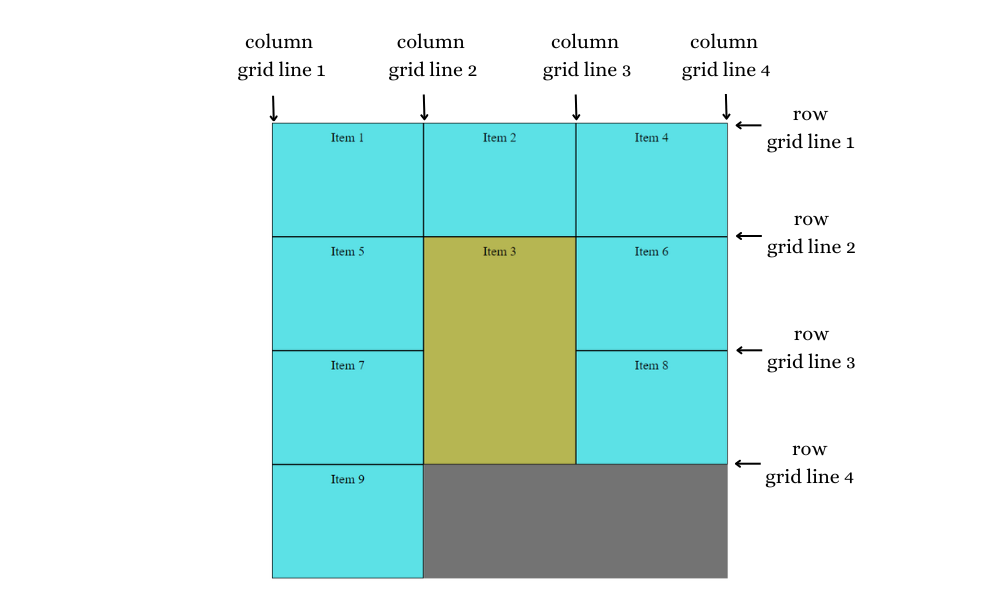
grid-row
This property is a shorthand for setting both grid-row-start and grid-row-end in a single declaration.
Basic syntax:
grid-row: grid-row-start / grid-row-end;
Example:
.container {
display: grid;
grid-template-columns: 1fr 1fr 1fr;
}
.item:nth-child(3) {
grid-row: 3 / 4;
background-color: rgb(182, 182, 82);
}Here, the third item starts at row grid line 3 and ends at row grid line 4.

grid-column
This property is a shorthand for setting both grid-column-start and grid-column-end in a single declaration.
Basic syntax:
grid-column: grid-column-start / grid-column-end;
Example:
.container {
display: grid;
grid-template-columns: 1fr 1fr 1fr;
}
.item:nth-child(3) {
grid-column: 2 / 4;
background-color: rgb(182, 182, 82);
}Here, the third item starts at column grid line 2 and ends at column grid line 4.
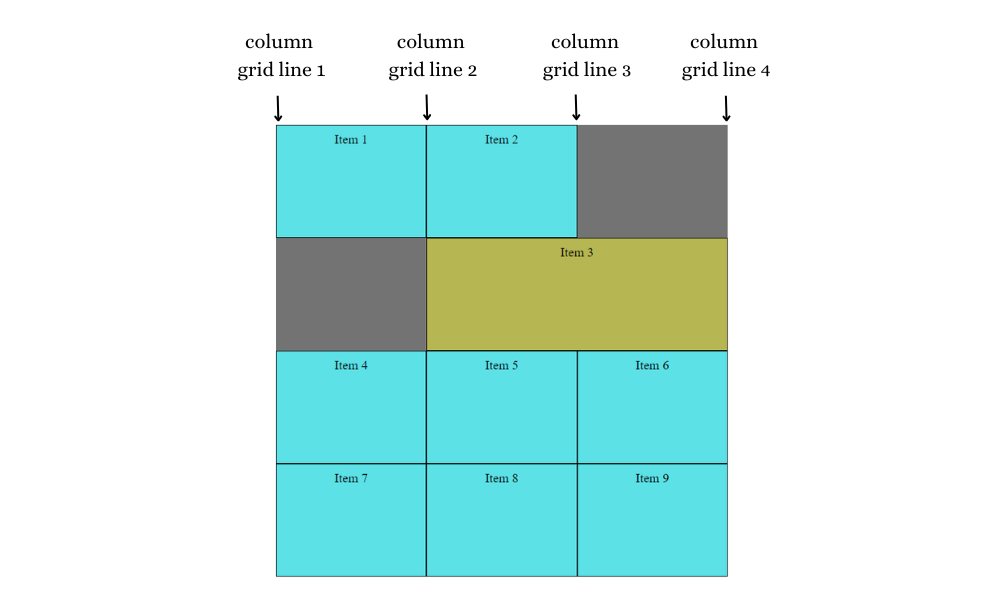
grid-area
This property is a shorthand property for grid-row-start, grid-column-start, grid-row-end and grid-column-end.
This property can also be used to assign a name to a grid item. Then these named grid items can be referenced to the grid-template-areas property of the grid container.
Basic syntax:
grid-area: grid-row-start / grid-column-start / grid-row-end / grid-column-end | griditemname;
Example: 1
.container {
display: grid;
grid-template-columns: 1fr 1fr 1fr;
}
.item:nth-child(3) {
grid-area: 2 / 4 / 4 / 2;
background-color: rgb(182, 182, 82);
}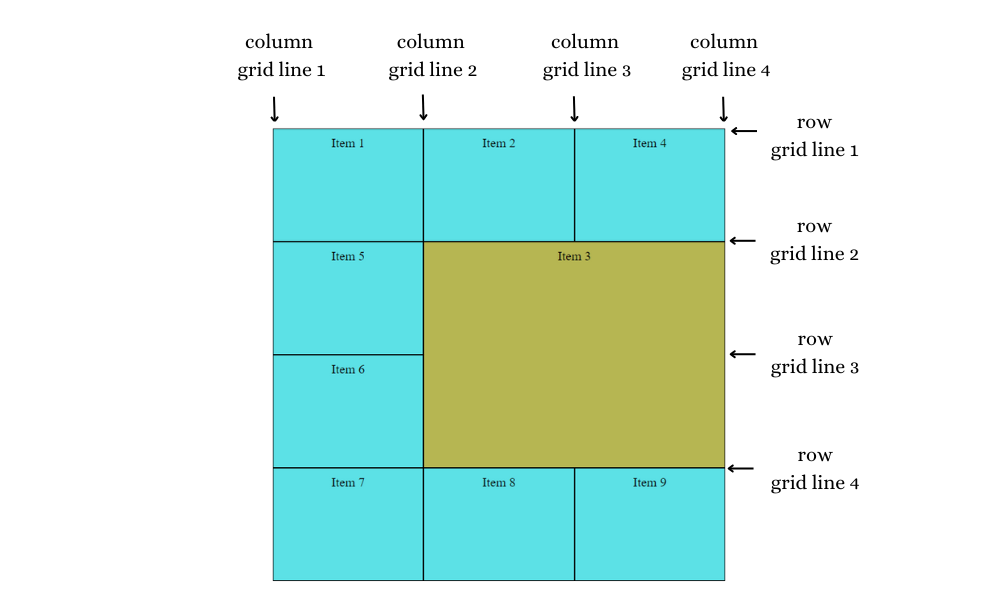
Example: 2
.container {
display: grid;
grid-template-columns: 1fr 1fr 1fr;
}
.item:nth-child(3) {
grid-area: myGridArea;
background-color: rgb(182, 182, 82);
}grid-template-areas
This property defines the overall structure of the grid layout by specifying the arrangement of named grid areas.
Example:
HTML:
<div class="container"> <div class="item header">Header</div> <div class="item sidebar">Sidebar</div> <div class="item main">Main Content</div> <div class="item footer">Footer</div> </div>
CSS:
.item {
color: white;
text-align: center;
padding: 10px;
}
.container {
height: 700px;
width: 700px;
display: grid;
grid-template-rows: 150px 1fr 100px;
grid-template-columns: 1fr 2fr;
grid-template-areas:
"header header"
"sidebar main"
"footer footer";
}
.header {
grid-area: header;
background-color: #3498db;
}
.sidebar {
grid-area: sidebar;
background-color: #27ae60;
}
.main {
grid-area: main;
background-color: #f39c12;
}
.footer {
grid-area: footer;
background-color: #12acf3;
}In this layout, we’ve organized our grid into three rows and two columns.
Using the grid-template-areas property, we’ve given meaningful names to each grid cell, defining the layout’s structure. The top row consists of two cells both named “header,” the second row contains the “sidebar” and “main” areas, and the third row repeats the “footer” area twice.
To position each grid item within this structure, we’ve used the grid-area property. This establishes a connection between the grid items and the named areas we’ve defined in grid-template-areas.

Functions
In CSS Grid, there are several built-in functions that you can use to define the size of grid tracks (rows and columns). These functions help your grid to adjust in different screen sizes, making your layouts more responsive.
Following are some commonly used functions in CSS Grid:
repeat() Function
This function lets you use the same pattern of track sizes for both rows and columns in a grid.
You can use the repeat() function as a value for the grid-template-columns or grid-template-rows properties.
Syntax:
repeat(number of repetitions, size of each repetition)
The number of repetitions can be a number, auto-fill or auto-fit.
The size can be a length (px, em, rem, etc.), a percentage, a flex value, or one of the keyword values max-content, min-content, or auto.
auto-fill: It creates as many tracks as needed to fill the grid container, even if some are empty. It doesn’t collapse empty tracks, so they’re visible but empty.
auto-fit: Similar to auto-fill, it makes as many tracks as needed, but here’s the difference: If some tracks are empty, auto-fit collapses them to take up zero space, so you won’t see gaps in your layout.
Example: 1
.container {
display: grid;
grid-template-columns: repeat(3, 1fr);
grid-template-rows: repeat(4, 200px);
}Here, this will create 3 columns each of width 1fr and 4 rows each of height 200px.
Example: 2
.container {
display: grid;
grid-template-columns: repeat(auto-fill, 70px);
}minmax() Function
This function sets a range of sizes for grid tracks, so they can be both small and big within certain limits. That means it sets a minimum and maximum size.
You can use the minmax() function as a value for grid-template-columns ,grid-template-rows ,grid-auto-columns and grid-auto-rows properties.
Syntax:
minmax(minimum size, maximum size)
Each parameter can be a length (px, em, rem, etc.), a percentage, a flex value, or one of the keyword values max-content, min-content, or auto.
If the maximum size is less than the minimum size, then the maximum will be ignored and minmax(min, max) will be treated as minimum.
Example:
.container {
display: grid;
grid-template-columns: minmax(100px, 200px) 1fr 1fr;
}Here, this will create 3 columns. The first column will remain between 100px and 200px when the screen shrinks and the remaining two columns will adjust according to the available remaining space.
fit-content() Function
This function allows you to specify the size of a grid item based on its content.
Syntax:
fit-content(size);
The size can be a length (px, em, rem, etc.), a percentage, a flex value, or one of the keyword values max-content, min-content, or auto.
Example:
.container {
display: grid;
grid-template-columns: fit-content(100px) 1fr;
}Here, the first column will be sized to fit its content up to a maximum width of 100 pixels, and the second column will take up the remaining available space.
Conclusion
CSS Grid Layout is a powerful layout system that simplifies the creation of complex and responsive web layouts. By utilizing the properties and functions associated with CSS Grid Layout, you can easily organize and align elements within a two-dimensional grid structure.
Here are the key takeaways from this post:
- CSS Grid Basics: CSS Grid involves a grid container (created with
display: grid;) and grid items (direct children of the container). - Grid Structure: Understanding terms like grid lines, grid cells, grid tracks, grid areas, and gutters is crucial for building grid layouts.
- Fractional Units (fr): The
frunit distributes available space proportionally among grid items. - Grid Properties: Properties like
grid-template-columnsandgrid-template-rowsdefine the grid structure, whilegrid-templateis a shorthand for both. - Column and Row Gaps: Use
column-gap,row-gap, orgap(shorthand) to control the spacing between columns and rows. - Alignment: Properties like
justify-items,align-items, andplace-itemscontrol the alignment of grid items.justify-content,align-content, andplace-contentcontrol alignment of the grid content.justify-self,align-self, andplace-selfcontrol alignment of the grid items within their grid cells. - Grid Auto Flow: You can control how additional grid items are placed with
grid-auto-flow. - Item Placement: Individual grid items can be positioned within the grid using
grid-row-start,grid-column-start,grid-row-end,grid-column-end,grid-row,grid-column,grid-area, andgrid-template-areas. - Functions: Functions like
repeat(),minmax(), andfit-content()helps define responsive grid track sizes based on content and available space.
By mastering CSS Grid Layout and its associated properties, you can design web layouts that are not only visually appealing but also responsive to various screen sizes, enhancing the overall user experience.
That’s all for today!
If you’re new to web development, check out Learnify — my curated platform with beginner-friendly tutorials to help you learn web development step-by-step with examples and simple explanations.
If you enjoy my work and want to support what I do:
👉 Become a Patreon supporter
👉 Or buy me a coffeeEvery small gesture keeps me going! 💛
Follow me on X (Twitter) to get daily web development tips & insights.
Enjoyed reading? You may also find these articles helpful.
13 Properties of CSS Flexbox You Must Know As A Beginner
Mastering CSS Margin, Padding, and the Box Model
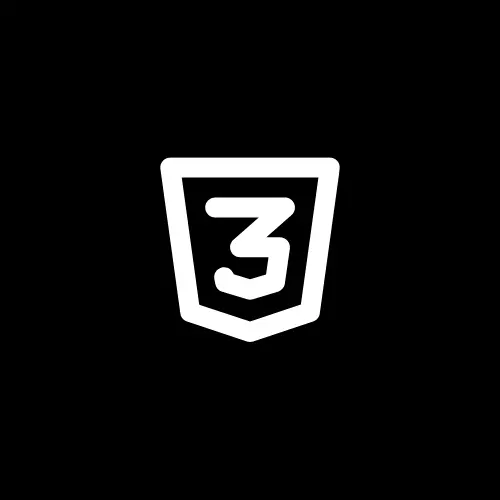
🚀 Wow, blog ini seperti petualangan fantastis meluncur ke alam semesta dari keajaiban! 💫 Konten yang menegangkan di sini adalah perjalanan rollercoaster yang mendebarkan bagi pikiran, memicu kegembiraan setiap saat. 💫 Baik itu inspirasi, blog ini adalah harta karun wawasan yang menarik! #KemungkinanTanpaBatas Terjun ke dalam petualangan mendebarkan ini dari penemuan dan biarkan pikiran Anda terbang! 🚀 Jangan hanya mengeksplorasi, rasakan kegembiraan ini! #BahanBakarPikiran Pikiran Anda akan bersyukur untuk perjalanan menyenangkan ini melalui alam keajaiban yang tak berujung! ✨
I have been browsing on-line greater than three hours today, yet I never found any fascinating
article like yours. It is lovely worth enough for me.
Personally, if all site owners and bloggers made excellent content as you did,
the net will probably be a lot more useful than ever before.
Great article
This content brought immense joy to my day! 😄 Keep creating posts like this!
Your post is a ray of light in the darkness. Thank you for brightening my day in a unique way. Keep shining! ☀️
Simply wish to say your article is as astounding. The clearness in your post is simply great and
i can assume you are an expert on this subject. Well with your permission let me to grab your feed to keep up to date with forthcoming
post. Thanks a million and please continue the rewarding work.
Hi, I do believe this is a great website. I stumbledupon it 😉 I’m going to come back once again since i have saved
as a favorite it. Money and freedom is the greatest way
to change, may you be rich and continue to help other people.
Woah! I’m really loving the template/theme of this blog. It’s simple,
yet effective. A lot of times it’s very hard to get that
“perfect balance” between usability and visual appeal.
I must say that you’ve done a amazing job with this.
Additionally, the blog loads super quick for me on Chrome.
Outstanding Blog!
That really means a lot. Thank you so much!
This is very interesting, You’re an excessively skilled
blogger. I’ve joined your feed and sit up for in quest of more of your wonderful post.
Also, I have shared your site in my social networks
Thank you so very much🙏
Hi there mates, its enormous article about educationand fully explained,
keep it up all the time.
Thanks for sharing. I read many of your blog posts, cool, your blog is very good.